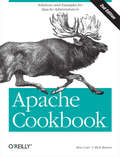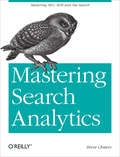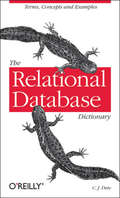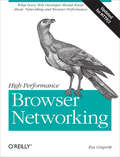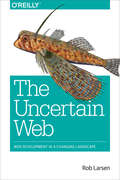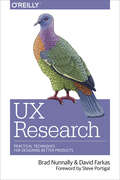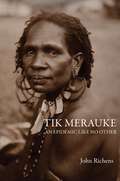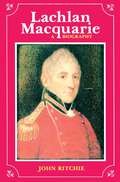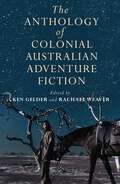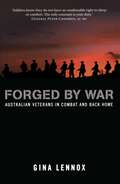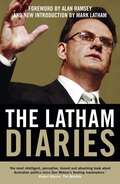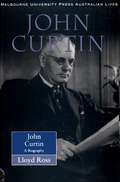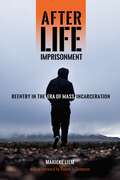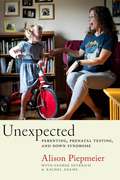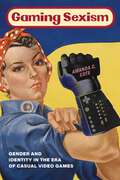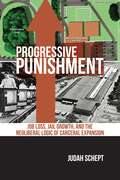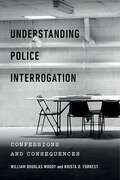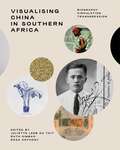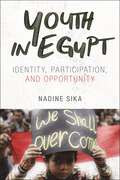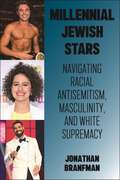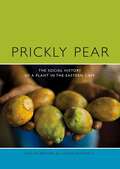- Table View
- List View
Linux Networking Cookbook: From Asterisk to Zebra with Easy-to-Use Recipes (Linux)
by Carla SchroderThis soup-to-nuts collection of recipes covers everything you need to know to perform your job as a Linux network administrator, whether you're new to the job or have years of experience. With Linux Networking Cookbook, you'll dive straight into the gnarly hands-on work of building and maintaining a computer network.Running a network doesn't mean you have all the answers. Networking is a complex subject with reams of reference material that's difficult to keep straight, much less remember. If you want a book that lays out the steps for specific tasks, that clearly explains the commands and configurations, and does not tax your patience with endless ramblings and meanderings into theory and obscure RFCs, this is the book for you.You will find recipes for:Building a gateway, firewall, and wireless access point on a Linux networkBuilding a VoIP server with AsteriskSecure remote administration with SSHBuilding secure VPNs with OpenVPN, and a Linux PPTP VPN serverSingle sign-on with Samba for mixed Linux/Windows LANsCentralized network directory with OpenLDAPNetwork monitoring with Nagios or MRTGGetting acquainted with IPv6Setting up hands-free networks installations of new systemsLinux system administration via serial consoleAnd a lot more. Each recipe includes a clear, hands-on solution with tested code, plus a discussion on why it works. When you need to solve a network problem without delay, and don't have the time or patience to comb through reference books or the Web for answers, Linux Networking Cookbook gives you exactly what you need.
Apache Cookbook: Solutions and Examples for Apache Administration
by Rich Bowen Ken CoarThere's plenty of documentation on installing and configuring the Apache web server, but where do you find help for the day-to-day stuff, like adding common modules or fine-tuning your activity logging? That's easy. The new edition of the Apache Cookbook offers you updated solutions to the problems you're likely to encounter with the new versions of Apache.Written by members of the Apache Software Foundation, and thoroughly revised for Apache versions 2.0 and 2.2, recipes in this book range from simple tasks, such installing the server on Red Hat Linux or Windows, to more complex tasks, such as setting up name-based virtual hosts or securing and managing your proxy server. Altogether, you get more than 200 timesaving recipes for solving a crisis or other deadline conundrums, with topics including:SecurityAliases, Redirecting, and RewritingCGI Scripts, the suexec Wrapper, and other dynamic content techniquesError HandlingSSLPerformanceThis book tackles everything from beginner problems to those faced by experienced users. For every problem addressed in the book, you will find a worked-out solution that includes short, focused pieces of code you can use immediately. You also get explanations of how and why the code works, so you can adapt the problem-solving techniques to similar situations.Instead of poking around mailing lists, online documentation, and other sources, rely on the Apache Cookbook for quick solutions when you need them. Then you can spend your time and energy where it matters most.
Mastering Search Analytics: Measuring SEO, SEM and Site Search (O'reilly Ser.)
by Brent ChatersMany companies still approach Search Engine Optimization (SEO) and paid search as separate initiatives. This in-depth guide shows you how to use these programs as part of a comprehensive strategy—not just to improve your site’s search rankings, but to attract the right people and increase your conversion rate.Learn how to measure, test, analyze, and interpret all of your search data with a wide array of analytic tools. Gain the knowledge you need to determine the strategy’s return on investment. Ideal for search specialists, webmasters, and search marketing managers, Mastering Search Analytics shows you how to gain better traffic and more revenue through your search efforts.Focus on conversion and usability—not on driving larger volumes of trafficTrack the performance of your SEO and paid search keywordsApply techniques to monitor what your competitors are doingUnderstand the differences between mobile and desktop searchLearn how social media impacts your search rankings and resultsAudit your site for problems that can affect users and search spidersCreate dashboards and expanded reports for all of your search activities
The Relational Database Dictionary: A Comprehensive Glossary of Relational Terms and Concepts, with Illustrative Examples
by C. J. DateAvoid misunderstandings that can affect the design, programming, and use of database systems. Whether you're using Oracle, DB2, SQL Server, MySQL, or PostgreSQL, The Relational Database Dictionary will prevent confusion about the precise meaning of database-related terms (e.g., attribute, 3NF, one-to-many correspondence, predicate, repeating group, join dependency), helping to ensure the success of your database projects. Carefully reviewed for clarity, accuracy, and completeness, this authoritative and comprehensive quick-reference contains more than 600 terms, many with examples, covering issues and concepts arising from the relational model of data. This one-of-a-kind dictionary provides a single, compact source where DBAs, database designers, DBMS implementers, application developers, and database professors and students can find the accurate definitions they need on a daily basis, information that isn't readily available anywhere else. If you're working with or learning about relational databases, you need this pocket-sized quick-reference.
High Performance Browser Networking: What every web developer should know about networking and web performance
by Ilya GrigorikHow prepared are you to build fast and efficient web applications? This eloquent book provides what every web developer should know about the network, from fundamental limitations that affect performance to major innovations for building even more powerful browser applicationsâ??including HTTP 2.0 and XHR improvements, Server-Sent Events (SSE), WebSocket, and WebRTC.Author Ilya Grigorik, a web performance engineer at Google, demonstrates performance optimization best practices for TCP, UDP, and TLS protocols, and explains unique wireless and mobile network optimization requirements. Youâ??ll then dive into performance characteristics of technologies such as HTTP 2.0, client-side network scripting with XHR, real-time streaming with SSE and WebSocket, and P2P communication with WebRTC.Deliver superlative TCP, UDP, and TLS performanceSpeed up network performance over 3G/4G mobile networksDevelop fast and energy-efficient mobile applicationsAddress bottlenecks in HTTP 1.x and other browser protocolsPlan for and deliver the best HTTP 2.0 performanceEnable efficient real-time streaming in the browserCreate efficient peer-to-peer videoconferencing and low-latency applications with real-time WebRTC transports
The Uncertain Web: Web Development in a Changing Landscape
by Rob LarsenWhat’s the best way to develop for a Web gone wild? That’s easy. Simply scrap the rules you’ve relied on all these years and embrace uncertainty as a core tenet of design. In this practical book, veteran developer Rob Larsen outlines the principles out what he calls The Uncertain Web, and shows you techniques necessary to successfully make the transition.By combining web standards, progressive enhancement, an iterative approach to design and development, and a desire to question the status quo, your team can create sites and applications that will perform well in a wide range of present and future devices. This guide points the way.Topics include:Navigating thousands of browser/device/OS combinationsFocusing on optimal, not absolute solutionsFeature detection, Modernizr, and polyfillsRWD, mobile first, and progressive enhancementUIs that work with multiple user input modesImage optimization, SVG, and server-side optionsThe horribly complex world of web videoThe Web we want to see in the future
UX Research: Practical Techniques for Designing Better Products
by Brad Nunnally David FarkasOne key responsibility of product designers and UX practitioners is to conduct formal and informal research to clarify design decisions and business needs. But there’s often mystery around product research, with the feeling that you need to be a research Zen master to gather anything useful. Fact is, anyone can conduct product research. With this quick reference guide, you’ll learn a common language and set of tools to help you carry out research in an informed and productive manner.This book contains four sections, including a brief introduction to UX research, planning and preparation, facilitating research, and analysis and reporting. Each chapter includes a short exercise so you can quickly apply what you’ve learned.Learn what it takes to ask good research questionsKnow when to use quantitative and qualitative research methodsExplore the logistics and details of coordinating a research sessionUse softer skills to make research seem natural to participantsLearn tools and approaches to uncover meaning in your raw dataCommunicate your findings with a framework and structure
Tik Merauke: An Epidemic Like No Other
by John RichensWhen the Dutch government moved to stop headhunting by the Marind people of New Guinea in 1902 their actions unleashed new epidemics among a population already suffering from low fertility. Donovanosis (Tik Merauke in Marind), a rare, newly recognised sexually transmitted infection for which no medicine was available, affected huge numbers. This compelling book investigates the causes of this unique epidemic by exploring the fascinating lives and rituals of the Marind along with those of the missionaries, anthropologists, doctors, administrators, film makers and bird hunters swept up in the events. Tik Merauke shows how the discovery of an effective medicine brought relief, but how the coercive resettlement of the Marind into model villages has left a troubled legacy still felt by the surviving people.
Lachlan Macquarie: A Biography
by John Ritchie'Ritchie has provided an exciting and dramatic account of the life and work of Macquarie. We learn, in contrast to the antiseptic treatment of the standard text books, that Macquarie was a man of strong passions, beliefs, plans and ambitions which drove him to hobnob with polite London society, to beg for promotion and favours from his superiors, to wangle commissions for his relatives, to be generous to a fault with those he sought to help and to demand unquestioning support from those he promoted or pardoned.' Malcolm J. Kennedy, Agora
Settling the Office: The Australian Prime Ministership from Federation to Reconstruction
by Paul 't Hart James Walter Paul StrangioThe prime ministership is indisputably the most closely observed and keenly contested office in Australia. How did it grow to become the pivot of national political power? Settling the Office chronicles the development of the prime ministership from its rudimentary early days following Federation through to the powerful, institutionalised prime-ministerial leadership of the postwar era.
Anthology Of Colonial Australian Adventure Fiction
by Ken Gelder Rachael WeaverMarauding bushrangers, lost explorers, mad shepherds, new chums and mounted troopers: these are some of the characters who populate the often perilous world of colonial Australian adventure fiction. Squatters defend their hard-earned properties from attack, while floods and other natural disasters threaten to wipe any trace of settlement away. Colonial Australian adventure fiction takes its characters on a journey into remote and unfamiliar territory, often in pursuit of wealth and well-being. But these journeys are invariably fraught with danger, and everything comes at a price. This anthology collects the best examples of colonial Australian adventure fiction, with stories by Ernest Favenc, Louis Becke, Rosa Praed, Guy Boothby, and many others. Also available in this series: The Anthology of Colonial Australian Gothic Fiction The Anthology of Colonial Australian Crime Fiction The Anthology of Colonial Australian Romance Fiction
Forged By War: Australian Veterans in Combat and Back Home
by Gina LennoxIn Forged By War, Australian veterans and their families reveal the experience of combat and how it has changed their lives. These stark first-hand accounts describe the reality of military action and its personal consequences in every major conflict and peacemaking mission since World War II, including the invasion of Iraq. Sometimes the reader is in lockstep with a soldier on patrol, watching as a land mine explodes, or a local militiaman points an AK–47 at Australian peacemakers. Other times, the reader is inside a returned veteran's head, feeling their superfluous adrenalin, their need to control their environment, even at home. With accounts from Peter and Lynne Cosgrove, Graham Edwards, Frank Hunt (I Was Only Nineteen), other veterans of Vietnam, Glenda Humes (daughter of Capt Reginald Saunders), peacemakers and an SAS trooper, this compelling investigation by Gina Lennox in underpinned by the question: where does family fit in a soldier's life?
Latham Diaries
by Mark LathamHere are the political diaries of one of Australia's most promising national leaders—published within twelve months of his resignation from office—an historic first. The Latham Diaries are searingly honest bulletins from the front line of Labor politics. They provide a unique view into the life of a man, the Party and the nation at a crucial time in Australian history.Mark Latham resigned from parliament in January 2005, after only fourteen months as Leader of the Opposition, amid bitter post-election recrimination and his own ill health. From the beginning of his career he was viewed by many observers as the ALP's resident intellectual and larrikin, the great hope of a new generation with the drive and talent to become prime minister.So why did his career end so abruptly? As The Latham Diaries reveal, the rising tide of public cynicism about politics, the cult of celebrity, the dangerous liaison between politics and the media, and the sickness at the heart of the Labor machine all played their part. As did Latham's own errors, as he candidly records in these diaries.This is a riveting chronicle of life inside politics: the backroom deals, the frontroom conniving, the bitter defeat of idealism and the triumph of opportunism. The Latham Diaries is not just the story of the Labor Party in the last years of the twentieth century and the early twenty-first century, but a sobering account of the state of Australian democracy 100 years after Federation.
John Curtin
by Lloyd RossThis is an important classic biography of an Australian Prime Minister whose life still exerts an abiding influence on Australian society and national consciousness—a key figure in Australian history. 'Curtin was a complex character. Warm and sympathetic, but cold and aloof; a comrade but a loner; a rebel and anti-conscriptionist but Prime Minister. Moody; irritable; uncertain; changeable; vacillating; temperamental; opportunist; sentimental; courageous; all are true of Curtin.' Lloyd Ross sums up the character of the wartime Labor Prime Minister who fought Churchill to bring back Australian troops from Europe to defend our nation. An intense and passionate orator, Curtin inspired respect in cynical Australians by his unassuming dignity, straightforwardness and refusal of any personal privilege.
After Life Imprisonment: Reentry in the Era of Mass Incarceration (New Perspectives in Crime, Deviance, and Law #13)
by Marieke LiemOne out of every ten prisoners in the United States is serving a life sentence—roughly 130,000 people. While some have been sentenced to life in prison without parole, the majority of prisoners serving ‘life’ will be released back into society. But what becomes of those people who reenter the everyday world after serving life in prison?In After Life Imprisonment, Marieke Liem carefully examines the experiences of “lifers” upon release. Through interviews with over sixty homicide offenders sentenced to life but granted parole, Liem tracks those able to build a new life on the outside and those who were re-incarcerated. The interviews reveal prisoners’ reflections on being sentenced to life, as well as the challenges of employment, housing, and interpersonal relationships upon release. Liem explores the increase in handing out of life sentences, and specifically provides a basis for discussions of the goals, costs, and effects of long-term imprisonment, ultimately unpacking public policy and discourse surrounding long-term incarceration. A profound criminological examination, After Life Imprisonment reveals the untold, lived experiences of prisoners before and after their life sentences.
Unexpected: Parenting, Prenatal Testing, and Down Syndrome
by Alison PiepmeierWhat prenatal tests and down syndrome reveal about our reproductive choicesWhen Alison Piepmeier—scholar of feminism and disability studies, and mother of Maybelle, an eight-year-old girl with Down syndrome—died of cancer in August 2016, she left behind an important unfinished manuscript about motherhood, prenatal testing, and disability. In Unexpected, George Estreich and Rachel Adams pick up where she left off, honoring the important research of their friend and colleague, as well as adding new perspectives to her work.Based on interviews with parents of children with Down syndrome, as well as women who terminated their pregnancies because their fetus was identified as having the condition, Unexpected paints an intimate, nuanced picture of reproductive choice in today’s world. Piepmeier takes us inside her own daughter’s life, showing how Down syndrome is misunderstood, stigmatized, and condemned, particularly in the context of prenatal testing.At a time when medical technology is rapidly advancing, Unexpected provides a much-needed perspective on our complex, and frequently troubling, understanding of Down syndrome.
Gaming Sexism: Gender and Identity in the Era of Casual Video Games
by Amanda C. CoteInterviews with female gamers about structural sexism across the gaming landscapeWhen the Nintendo Wii was released in 2006, it ushered forward a new era of casual gaming in which video games appealed to not just the stereotypical hardcore male gamer, but also to a much broader, more diverse audience. However, the GamerGate controversy six years later, and other similar public incidents since, laid bare the internalized misogyny and gender stereotypes in the gaming community. Today, even as women make up nearly half of all gamers, sexist assumptions about the what and how of women’s gaming are more actively enforced.In Gaming Sexism, Amanda C. Cote explores the video game industry and its players to explain this contradiction, how it affects female gamers, and what it means in terms of power and gender equality. Across in-depth interviews with women-identified gamers, Cote delves into the conflict between diversification and resistance to understand their impact on gaming, both casual and “core” alike. From video game magazines to male reactions to female opponents, she explores the shifting expectations about who gamers are, perceived changes in gaming spaces, and the experiences of female gamers amidst this gendered turmoil. While Cote reveals extensive, persistent problems in gaming spaces, she also emphasizes the power of this motivated, marginalized audience, and draws on their experiences to explore how structural inequalities in gaming spaces can be overcome. Gaming Sexism is a well-timed investigation of equality, power, and control over the future of technology.
Progressive Punishment: Job Loss, Jail Growth, and the Neoliberal Logic of Carceral Expansion (Alternative Criminology #1)
by Judah ScheptWinner, 2017 American Society of Criminology's Division on Critical Criminology and Social Justice Best Book AwardAn examination of the neoliberal politics of incarceration The growth of mass incarceration in the United States eludes neat categorization as a product of the political Right. Liberals played important roles in both laying the foundation for and then participating in the conservative tough on crime movement that is largely credited with the rise of the prison state. But what of those politicians and activists on the Left who reject punitive politics in favor of rehabilitation and a stronger welfare state? Can progressive policies such as these, with their benevolent intentions, nevertheless contribute to the expansion of mass incarceration?In Progressive Punishment, Judah Schept offers an ethnographic examination into the politics of incarceration in Bloomington, Indiana in order to consider the ways that liberal discourses about therapeutic justice and rehabilitation can uphold the logics, practices and institutions that comprise the carceral state. Schept examines how political leaders on the Left, despite being critical of mass incarceration, advocated for a “justice campus” that would have dramatically expanded the local criminal justice system. At the root of this proposal, Schept argues, is a confluence of neoliberal-style changes in the community that naturalized prison expansion as political common sense among leaders negotiating crises of deindustrialization, urban decline, and the devolution of social welfare. In spite of the momentum that the proposal gained, Schept uncovers resistance among community organizers, who developed important strategies and discourses to challenge the justice campus, disrupt some of the logics that provided it legitimacy, and offer new possibilities for a non-carceral community. A well-researched and well-narrated study, Progressive Punishment offers a novel perspective on the relationship between liberal politics, neoliberalism, and mass incarceration.
Understanding Police Interrogation: Confessions and Consequences (Psychology and Crime #4)
by William Douglas Woody Krista D. ForrestUses techniques from psychological science and legal theory to explore police interrogation in the United States Understanding Police Interrogation provides a single comprehensive source for understanding issues relating to police interrogation and confession. It sheds light on the range of factors that may influence the outcome of the interrogation of a suspect, which ones make it more likely that a person will confess, and which may also inadvertently lead to false confessions. There is a significant psychological component to police interrogations, as interrogators may try to build rapport with the suspect, or trick them into thinking there is evidence against them that does not exist. Also important is the extent to which the interrogator is convinced of the suspect’s guilt, a factor that has clear ramifications for today’s debates over treatment of black suspects and other people of color in the criminal justice system. The volume employs a totality of the circumstances approach, arguing that a number of integrated factors, such as the characteristics of the suspect, the characteristics of the interrogators, interrogation techniques and location, community perceptions of law enforcement, and expectations for jurors and judges, all contribute to the nature of interrogations and the outcomes and perceptions of the criminal justice system. The authors argue that by drawing on this approach we can better explain the likelihood of interrogation outcomes, including true and false confessions, and provide both scholars and practitioners with a greater understanding of best practices going forward.
Visualising China in Southern Africa: Biography, Circulation, Transgression
by Juliette Leeb-du Toit Ruth Simbao Ross Anthony Rui Assubuji Ying Cheng Malcolm Corrigall Romain Dittgen Esther Esmyol Philip Harrison Patricia Hayes Binjun Hu T Tu Huynh Nicola Kritzinger Mark Lewis Khangelani Moyo Stary Mwaba Marcus Neustetter Kristin NG-Yang Gemma Rodrigues Shuo Wang Yan Yang Lifang ZhangChina and Africa have long shared a history of allegiance and contact points through global political forces from the time of colonialism and the Cold War. With China’s rise as the new superpower, its presence in Africa has expanded, leading to significant economic, geopolitical and cultural shifts. While issues such as trade, aid and development have received much attention, Chinese and African encounters through the lens of the visual arts and material culture is a neglected field.Visualising China in Southern Africa: Biography, Circulation, Transgression is a ground-breaking volume that addresses this deficit through engaging with the work of contemporary African and Chinese artists while analysing broader material production that prefigures the current relationship. The essays are wide-ranging in their analysis of ceramics, photography, painting, etching, sculpture, film, performance, postcards, stamps, installations, political posters, cartoons and architecture.Visualising China in Southern Africa confines its focus to southern Africa, yet even within this region, the context is complex. Ethnicity and nationalism, the lingering influence of Cold War allegiances and colonial configurations all continue to play a role. The various visual cultures discussed in this volume emphasise the commonality of these categories, but also point towards other shared histories that transcend the nation-state category.The collection includes scholarly chapters, photo essays, interviews, and artists’ personal accounts, organised around four themes: material flows, orientations and transgressions, spatial imaginaries, and biographies. The artists, photographers, filmmakers, curators and collectors in this volume include: Stary Mwaba, Hua Jiming, Anawana Haloba, Gerald Machona, Nobukho Nqaba, Marcus Neustetter, Brett Murray, Diane Victor, William Kentridge, Kristin NG-Yang, Kok Nam, Mark Lewis, the Chinese Camera Club of South Africa, Wu Jing, Henion Han and Shengkai Wu.
Youth in Egypt: Identity, Participation, and Opportunity
by Nadine SikaAn eye-opening look at youth in contemporary Egypt, from the role they play in advancing political change to their everyday strugglesIn Youth in Egypt, Nadine Sika explores the political world of young people in Egypt, focusing on their experiences under authoritarianism. From the reigns of Gamal Abdel Nasser and Anwar Sadat to that of Abdel Fattah el-Sisi, she offers an on-the-ground perspective through the eyes of multiple generations of young people who lived through consecutive periods of political upheaval and state militarization.Drawing on surveys, interviews, and focus groups, Sika shines a light on youth who have participated in protest movements, civil society organizations, and political parties. She shows us the different opportunities for economic and political participation that exist for them, explaining why young Egyptians may choose to either mobilize against or—surprisingly—in support of the regime. Sika underscores how youth in Egypt have been regarded as both the “hope of the nation” and a “threat to the nation.” Youth in Egypt shines a light on the rising generation of young people that represents Egypt's future and also has significant implications for the broader Middle East and North Africa region.
Millennial Jewish Stars: Navigating Racial Antisemitism, Masculinity, and White Supremacy
by Jonathan BranfmanHighlights how millennial Jewish stars symbolize national politics in US mediaJewish stars have longed faced pressure to downplay Jewish identity for fear of alienating wider audiences. But unexpectedly, since the 2000s, many millennial Jewish stars have won stellar success while spotlighting (rather than muting) Jewish identity. In Millennial Jewish Stars, Jonathan Branfman asks: what makes these explicitly Jewish stars so unexpectedly appealing? And what can their surprising success tell us about race, gender, and antisemitism in America? To answer these questions, Branfman offers case studies on six top millennial Jewish stars: the biracial rap superstar Drake, comedic rapper Lil Dicky, TV comedy duo Abbi Jacobson and Ilana Glazer, “man-baby” film star Seth Rogen, and chiseled film star Zac Efron.Branfman argues that despite their differences, each star’s success depends on how they navigate racial antisemitism: the historical notion that Jews are physically inferior to Christians. Each star especially navigates racial stigmas about Jewish masculinity—stigmas that depict Jewish men as emasculated, Jewish women as masculinized, and both as sexually perverse. By embracing, deflecting, or satirizing these stigmas, each star comes to symbolize national hopes and fears about all kinds of hot-button issues. For instance, by putting a cuter twist on stereotypes of Jewish emasculation, Seth Rogen plays soft man-babies who dramatize (and then resolve) popular anxieties about modern fatherhood. This knack for channeling national dreams and doubts is what makes each star so unexpectedly marketable.In turn, examining how each star navigates racial antisemitism onscreen makes it easier to pinpoint how antisemitism, white privilege, and color-based racism interact in the real world. Likewise, this insight can aid readers to better notice and challenge racial antisemitism in everyday life.
Prickly Pear: A Social History of a Plant in the Eastern Cape
by William BeinartAn explanation of how an invasive cactus from Mexico became a source of income in AfricaWhile there are many studies of the global influence of crops and plants, this is perhaps the first social history based around a plant in South Africa. Plants are not quite historical actors in their own right, but their properties and potential help to shape human history. Plants such as prickly pear tend to be invisible to those who do not use them, or at least on the peripheries of people's consciousness. This book explains why they were not peripheral to many people in the Eastern Cape and why a wild and sometimes invasive cactus from Mexico, that found its way around the world over 200 years ago, remains important to African women in shacks and small towns. The central tension at the heart of this history concerns different and sometimes conflicting human views of prickly pear. Some accepted or enjoyed its presence; others wished to eradicate it. While commercial livestock farmers initially found the plant enormously valuable, they came to see it as a scourge in the early twentieth century as it invaded farms and commonages. But for impoverished rural and small town communities of the Eastern Cape it was a godsend. In some places it still provides a significant income for poor black families. Debates about prickly pear - and its cultivated spineless variety - have played out in unexpected ways over the last century and more. Some scientists, once eradicationists, now see varieties of spineless cactus as plants for the future, eminently suited to a world beset by climate change and global warming. The book also addresses central problems around concepts of biodiversity. How do we balance, on the one hand, biodiversity conservation with, on the other, a recognition that plant transfers - and species transfers more generally - have been part of dynamic production systems that have historically underpinned human civilizations. American plants such as maize, cassava and prickly pear have been used to create incalculable value in Africa. Transferred plants are at the heart of many agricultural systems, as well as hybrid botanical and cultural landscapes, sometimes treasured, that are unlikely to be entirely reversed. Some of these plants displace local species, but are invaluable for local livelihoods. Prickly Pear explores this dilemma over the long term and suggests that there must be a significant cultural dimension to ideas about biodiversity. The content of Prickly Pear is based on intensive archival research, on interviews conducted in the Eastern Cape by the authors, as well as on their observations of how people in the area use and consume the plant.
Prototype to Product: A Practical Guide for Getting to Market
by Alan CohenProduct development is the magic that turns circuitry, software, and materials into a product, but moving efficiently from concept to manufactured product is a complex process with many potential pitfalls. This practical guide pulls back the curtain to reveal what happens—or should happen—when you take a product from prototype to production.For makers looking to go pro or product development team members keen to understand the process, author Alan Cohen tracks the development of an intelligent electronic device to explain the strategies and tactics necessary to transform an abstract idea into a successful product that people want to use.Learn 11 deadly sins that kill product development projectsGet an overview of how electronic products are manufacturedDetermine whether your idea has a good chance of being profitableNarrow down the product’s functionality and associated costsGenerate requirements that describe the final product’s detailsSelect your processor, operating system, and power sourcesLearn how to comply with safety regulations and standardsDive into development—from rapid prototyping to manufacturingAlan Cohen, a veteran systems and software engineering manager and lifelong technophile, specializes in leading the development of medical devices and other high-reliability products. His passion is to work with engineers and other stakeholders to forge innovative technologies into successful products.
BioCoder #7: Spring 2015 (DIY/BIO Newsletter #7)
by Inc. O'Reilly MediaBioCoder is a quarterly newsletter for DIYbio, synthetic bio, and anything related. You’ll discover:Articles about interesting projects and experiments, such as the glowing plantArticles about tools, both those you buy and those you buildVisits to DIYbio laboratoriesProfiles of key people in the communityAnnouncements of events and other items of interestSafety pointers and tips about good laboratory practiceAnything that’s interesting or useful: you tell us!And BioCoder is free (for the time being), unless you want a dead-tree version. We’d like BioCoder to become self supporting (maybe even profitable), but we’ll worry about that after we’ve got a few issues under our belt.If you’d like to contribute, send email to BioCoder@oreilly.com. Tell us what you’d like to do, and we’ll get you started.

